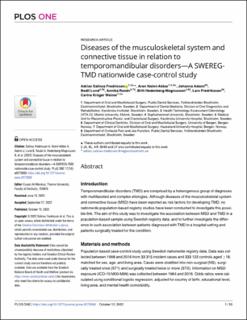Diseases of the musculoskeletal system and connective tissue in relation to temporomandibular disorders—A SWEREG-TMD nationwide case-control study
Fredricson, Adrian Salinas; Naimi-Akbar, Aron; Adami, Johanna; Lund, Bodil Kristina; Rosén, Annika; Hedenberg-Magnusson, Britt; Fredriksson, Lars; Weiner, Carina Krüger
Journal article, Peer reviewed
Published version

Åpne
Permanent lenke
https://hdl.handle.net/11250/3057449Utgivelsesdato
2022-10-12Metadata
Vis full innførselSamlinger
Sammendrag
Introduction: Temporomandibular disorders (TMD) are comprised by a heterogenous group of diagnoses with multifaceted and complex etiologies. Although diseases of the musculoskeletal system and connective tissue (MSD) have been reported as risk factors for developing TMD, no nationwide population-based registry studies have been conducted to investigate this possible link. The aim of this study was to investigate the association between MSD and TMD in a population-based sample using Swedish registry data, and to further investigate the difference in such association between patients diagnosed with TMD in a hospital setting and patients surgically treated for the condition.
Materials and methods: Population based case-control study using Swedish nationwide registry data. Data was collected between 1998 and 2016 from 33 315 incident cases and 333 122 controls aged ≥18, matched for sex, age, and living area. Cases were stratified into non-surgical (NS), surgically treated once (ST1) and surgically treated twice or more (ST2). Information on MSD exposure (ICD-10 M00-M99) was collected between 1964 and 2016. Odds ratios were calculated using conditional logistic regression, adjusted for country of birth, educational level, living area, and mental health comorbidity.
Results: A significant association between MSD and the development of TMD was found for all diagnostic categories: arthropathies (OR 2.0, CI 1.9–2.0); systemic connective tissue disorders (OR 2.3, CI 2.1–2.4); dorsopathies (OR 2.2, CI 2.1–2.2); soft tissue disorders (OR 2.2, CI 2.2–2.3); osteopathies and chondropathies (OR 1.7, CI 1.6–1.8); and other disorders of the musculoskeletal system and connective tissue (OR 1.9, CI 1.8–2.1). The associations were generally much stronger for TMD requiring surgical treatment. The diagnostic group with the strongest association was inflammatory polyarthropathies, M05-M14 (OR 11.7, CI 8.6–15.9), which was seen in the ST2 group.
Conclusions: Patients with MSD diagnoses have a higher probability of being diagnosed with TMD, in comparison to individuals without MSD. This association is even stronger for TMD that requires surgery. The results are in line with earlier findings, but present new population-based evidence of a possible causal relationship between MSD and TMD, even after adjusting for known confounders. Both dentists and physicians should be aware of this association and be wary of early signs of painful TMD among patients with MSD, to make early referral and timely conservative treatment possible.
